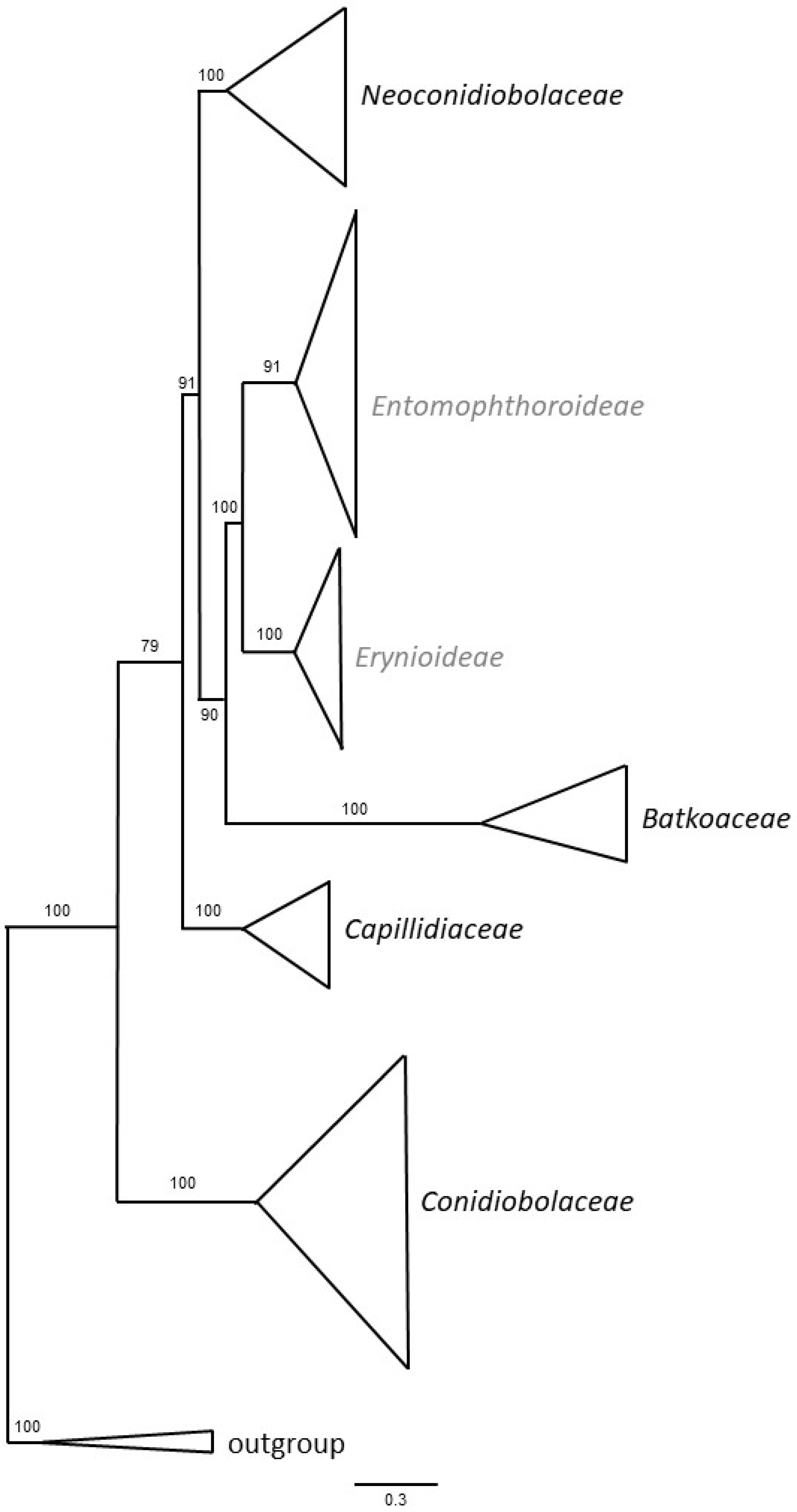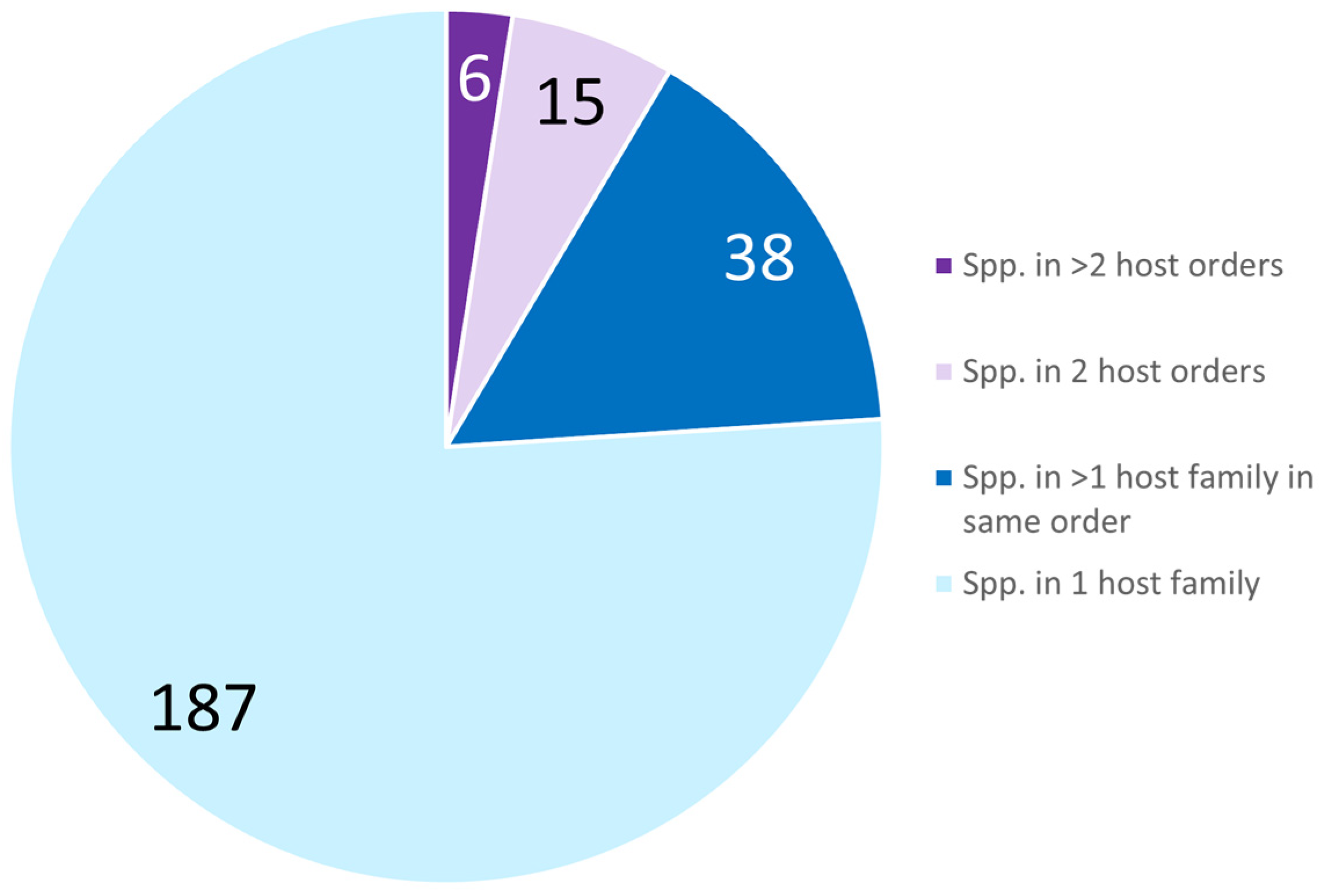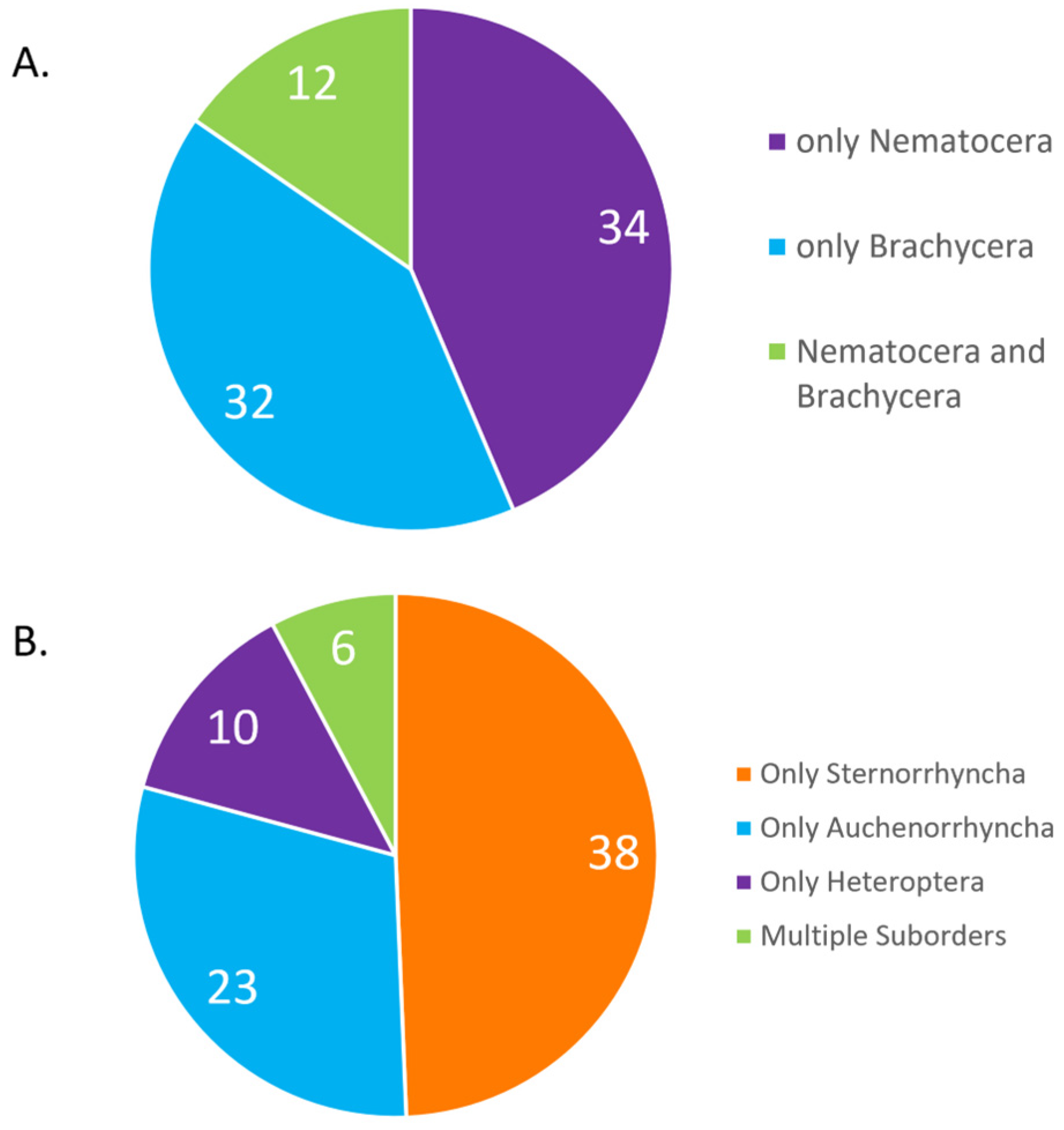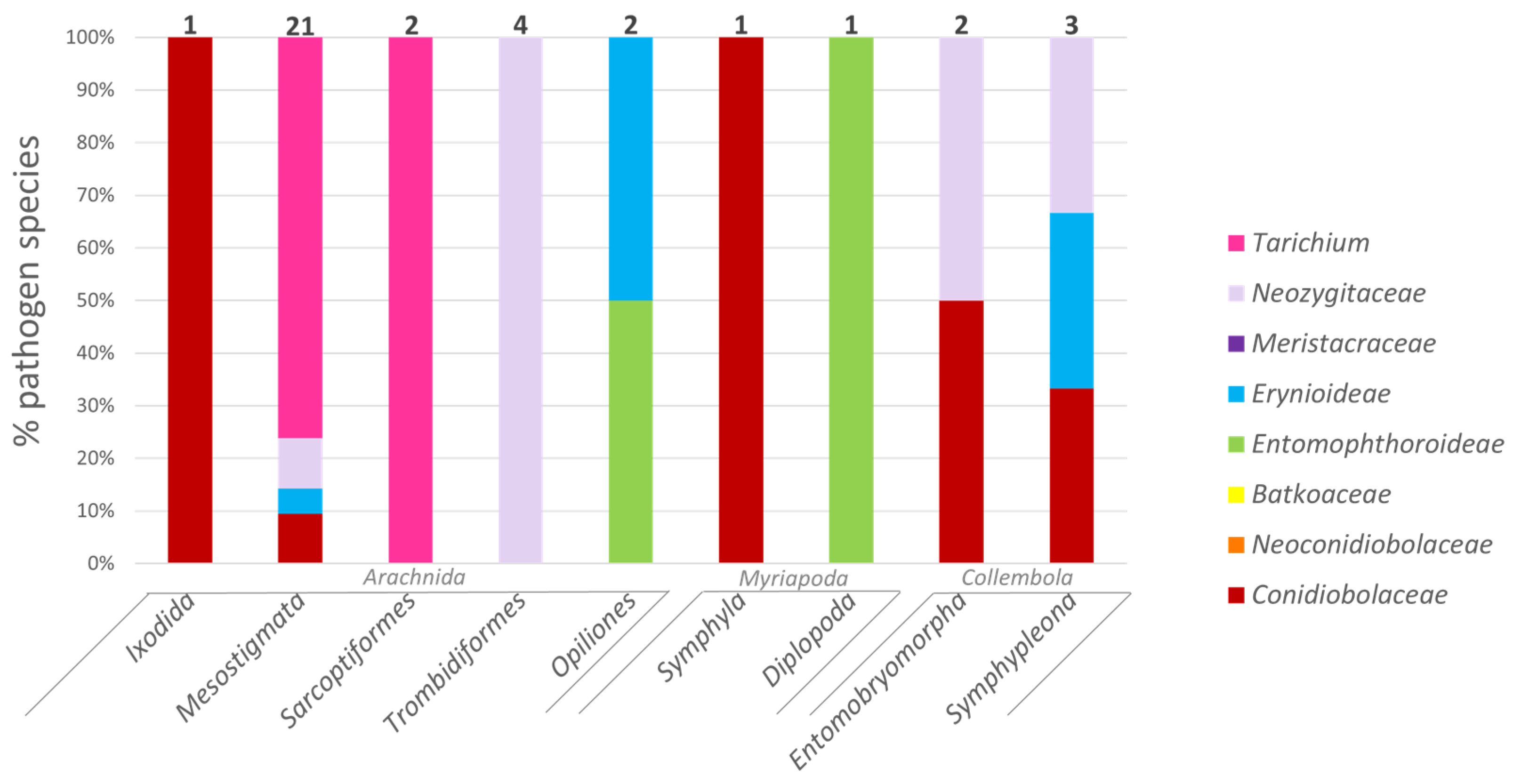Diversity and Breadth of Host Specificity among Arthropod Pathogens in the Entomophthoromycotina
Abstract
1. Introduction
2. Materials and Methods
3. Results
4. Discussion
Diversity of Arthropod-Pathogenic Species in the Entomophthoromycotina
5. Conclusions
Supplementary Materials
Author Contributions
Funding
Data Availability Statement
Acknowledgments
Conflicts of Interest
References
- Vega, F.E.; Meyling, N.V.; Luangsa-ard, J.J.; Blackwell, M. Fungal entomopathogens. In Insect Pathology, 2nd ed.; Vega, F.E., Kaya, H.K., Eds.; Academic Press: Amsterdam, The Netherlands, 2012; pp. 171–220. [Google Scholar]
- Woolhouse, M.E.J.; Taylor, L.H.; Haydon, D.T. Population biology of multihost pathogens. Science 2001, 292, 1109–1112. [Google Scholar] [CrossRef]
- Gryganskyi, A.P.; Golan, J.; Hajek, A.E. Season-long infection of diverse hosts by the entomopathogenic fungus Batkoa major. PLoS ONE 2022, 17, e0261912. [Google Scholar] [CrossRef]
- Hajek, A.E.; Clifton, E.H.; Stefanik, S.E.; Harris, D.C. Batkoa major infecting the invasive planthopper Lycorma delicatula. J. Invertebr. Pathol. 2022, 194, 107821. [Google Scholar] [CrossRef]
- Humber, R.A. Evolution of entomopathogenicity in fungi. J. Invertebr. Pathol. 2008, 98, 262–266. [Google Scholar] [CrossRef]
- Nie, Y.; Yu, D.-S.; Wang, C.-F.; Liu, X.-Y.; Huang, B. A taxonomic revision of the genus Conidiobolus (Ancylistaceae, Entomophthorales): Four clades including three new genera. MycoKeys 2020, 66, 55–81. [Google Scholar] [CrossRef]
- Möckel, L.; Meusemann, K.; Misof, B.; Schwartze, V.U.; De Fine Licht, H.H.; Voigt, K.; Stielow, B.; de Hoog, S.; Beutel, R.G.; Buellesbach, J. Phylogenetic revision and patterns of host specificity in the fungal subphylum Entomophthoromycotina. Microorganisms 2022, 10, 256. [Google Scholar] [CrossRef]
- Pell, J.; Eilenberg, J.; Hajek, A.E.; Steinkraus, D.C. Biology, ecology and pest management potential of Entomophthorales. In Fungi as Biocontrol Agents: Progress, Problems and Potential; Butt, T.M., Jackson, C.W., Magan, N., Eds.; CABI Publishing: Wallingford, UK, 2001; pp. 71–153. [Google Scholar]
- Bałazy, S. Entomophthorales. Flora of Poland. Fungi (Mycota); Polish Academy of Sciences: Krakow, Poland, 1993; Volume 24. [Google Scholar]
- Keller, S.; Wegensteiner, R. Introduction. In Arthropod-Pathogenic Entomophthorales: Biology, Ecology, Identification; COST Action 842; Keller, S., Ed.; COST Office: Luxembourg, 2007; pp. 1–6. [Google Scholar]
- Boomsma, J.J.; Jensen, A.B.; Meyling, N.V.; Eilenberg, J. Evolutionary interaction networks of insect pathogenic fungi. Annu. Rev. Entomol. 2014, 59, 467–485. [Google Scholar] [CrossRef]
- Domsch, K.H.; Gams, W.; Anderson, T.-H. Compendium of Soil Fungi; Academic Press: London, UK, 1980. [Google Scholar]
- Chen, M.J.; Yan, L.; Huang, B. Taxonomic position of Zoophthora radicans and its related species and analysis of nrDNA ITS of the isolates. Mycosystema 2019, 38, 1653–1660. [Google Scholar]
- Roy, H.; Hesketh, H.; Purse, B.; Eilenberg, J.; Santini, A.; Scalera, R.; Stentiford, G.; Adriaens, T.; Amtoft Wynns, A.; Bacela-Spychalska, K.; et al. Alien pathogens on the horizon: Opportunities for predicting their threat to wildlife. Conserv. Lett. 2017, 10, 477–484. [Google Scholar] [CrossRef]
- Fischer, M.C.; Henk, D.A.; Briggs, C.J.; Brownstein, J.S.; Madoff, L.C.; McGraws, S.L.; Gurr, S.J. Emerging fungal threats to animal, plant, and ecosystem health. Nature 2012, 484, 186–194. [Google Scholar] [CrossRef]
- Roy, H.E.; Steinkraus, D.C.; Eilenberg, J.; Hajek, A.E.; Pell, J.K. Bizarre interactions and endgames: Entomopathogenic fungi and their arthropod hosts. Annu. Rev. Entomol. 2006, 51, 331–357. [Google Scholar] [CrossRef]
- Gryganskyi, A.; Mullens, B.A.; Rehner, S.; Vilgalys, R.; Hajek, A.E. Hijacked: Co-option of host behavior by entomophthoralean fungi. PLoS Pathog. Pearls 2017, 13, e1006274. [Google Scholar] [CrossRef]
- Elya, C.; De Fine Licht, H.H. The genus Entomophthora: Bringing the insect destroyers into the twenty-first century. IMA Fungus 2021, 12, 34. [Google Scholar] [CrossRef]
- Elya, C.; Lok, T.C.; Spencer, Q.E.; McCausland, H.; Martinez, C.C.; Eisen, M. Robust manipulation of the behavior of Drosophila melanogaster by a fungal pathogen in the laboratory. eLife 2018, 7, e34414. [Google Scholar] [CrossRef]
- Boyce, G.R.; Gluck-Thaler, E.; Slot, J.C.; Stajich, J.E.; Davis, W.J.; James, T.Y.; Cooley, J.R.; Panaccione, D.G.; Eilenberg, J.; De Fine Licht, H.H.; et al. Psychoactive plant- and mushroom-associated alkaloids from two behavior modifying cicada pathogens. Fung. Ecol. 2019, 41, 147–164. [Google Scholar] [CrossRef]
- Cooley, J.R.; Marshall, D.C.; Hill, K.B.R. A specialized fungal parasite (Massospora cicadina) hijacks the sexual signals of periodical cicadas (Hemiptera: Cicadidae: Magicicada). Sci. Rep. 2018, 8, 1432. [Google Scholar] [CrossRef]
- Lovett, B.; Macias, A.; Stajich, J.E.; Cooley, J.; Eilenberg, J.; de Fine Licht, H.H.; Kasson, M.T. Behavioral betrayal: How select fungal parasites enlist living insects to do their bidding. PLoS Pathog. 2020, 16, e1008598. [Google Scholar] [CrossRef]
- Jensen, A.B.; Eilenberg, J. Genetic variation within the insect-pathogenic fungus genus Entomophthora, focusing on the E. muscae complex, using PCR-RFLP of the ITS II and the LSU rDNA. Mycol. Res. 2001, 105, 307–312. [Google Scholar] [CrossRef]
- Jensen, A.B.; Thomsen, L.; Eilenberg, J. Intraspecific variation and host specificity of Entomophthora muscae sensu stricto isolates revealed by random amplified polymorphic DNA, universal primed PCR, PCR-restriction fragment length polymorphism, and conidial morphology. J. Invertebr. Pathol. 2001, 78, 251–259. [Google Scholar] [CrossRef]
- Jensen, A.B.; Thomsen, L.; Eilenberg, J. Value of host range, morphological, and genetic characteristics within the Entomophthora muscae species complex. Mycol. Res. 2008, 110, 941–950. [Google Scholar] [CrossRef]
- Jensen, A.B.; Eilenberg, J.; López Lastra, C. Differential divergences of obligately insect-pathogenic Entomophthora species from fly and aphid hosts. FEMS Microbiol. Lett. 2009, 300, 180–187. [Google Scholar] [CrossRef]
- Lihme, M.; Jensen, A.B.; Rosendahl, S. Local scale population genetic structure of Entomophthora muscae epidemics. Fung. Ecol. 2009, 2, 81–86. [Google Scholar] [CrossRef]
- Gryganskyi, A.P.; Humber, R.A.; Stajich, J.E.; Mullens, B.; Anishchenko, I.M. Sequential utilization of hosts from different fly families by genetically distinct, sympatric populations within the Entomophthora muscae species complex. PLoS ONE 2013, 8, e71168. [Google Scholar] [CrossRef]
- Walsh, S.R.A. Development of Molecular Markers for the Detection and Differentiation of Entomophaga Strains Pathogenic to Insects. Ph.D. Thesis, University Toronto, Toronto, ON, Canada, 1996. [Google Scholar]
- Bidochka, M.J.; Walsh, S.R.A.; Ramos, M.E.; St. Leger, R.J.; Silver, J.C.; Roberts, D.W. Pathotypes of the Entomophaga grylli species complex of grasshopper pathogens differentiated with random amplification of polymorphic DNA and cloned-DNA probes. Appl. Environ. Microbiol. 1995, 61, 556–560. [Google Scholar] [CrossRef]
- Bidochka, M.J.; Walsh, S.R.A.; Ramos, M.E.; St. Leger, R.J.; Carruthers, R.I.; Silver, J.C.; Roberts, D.W. Cloned DNA probes distinguish endemic and exotic Entomophaga grylli fungal pathotype infections in grasshopper life stages. Mol. Ecol. 1997, 6, 303–308. [Google Scholar] [CrossRef]
- De Fine Licht, H.; Hajek, A.E.; Jensen, A.B.; Eilenberg, J. Utilizing genomics to study entomopathogenicity in the fungal phylum Entomophthoromycota: A review of current genetic resources. Adv. Gen. 2016, 94, 41–65. [Google Scholar]
- Stajich, J.E. Fungal genomes and insights into the evolution of the kingdom. Microbiol. Spectrum 2017, 5, FUNK-005502016. [Google Scholar] [CrossRef]
- Keller, S.; Hülsewig, T.; Jensen, A.B. Fungi attacking springtails (Smithuridae, Collembola) with a description of Pandora batallata, n. sp. (Entomophthoraceae). Sydowia 2023, 75, 37–45. [Google Scholar]
- Eilenberg, J.; Michelsen, V.; Jensen, A.B.; Humber, R.A. Strongwellsea selandia and Strongwellsea gefion (Entomophthorales: Entomophthoraceae), two new species infecting adult flies from genus Helina (Diptera: Muscidae). J. Invertebr. Pathol. 2022, 193, 107797. [Google Scholar] [CrossRef]
- Hawksworth, D.L.; Lücking, R. Fungal diversity revisited: 2.2 to 3.8 million species. Microbiol. Spectrum 2016, 5, FUNK-0052-2016. [Google Scholar]
- Zha, L.-S.; Wen, T.-C.; Hyde, K.D.; Kang, J.-C. An updated checklist of fungal species in Entomophthorales and their host insects from China. Mycosystema 2016, 35, 666–683. [Google Scholar]
- Kirk, P. Index Fungorum. Available online: www.indexfungorum.org (accessed on 11 November 2021).
- Spatafora, J.W.; Chang, Y.; Benny, G.L.; Lazarus, K.; Smith, M.E.; Berbee, M.L.; Bonito, G.; Corradi, N.; Grigoriev, I.; Gryganskyi, A.; et al. A phylum-level phylogenetic classification of zygomycete fungi based on genome-scale data. Mycologia 2016, 108, 1028–1046. [Google Scholar] [CrossRef]
- Bensch, K. Mycobank Database: Fungal Databases, Nomenclature & Species Banks. Available online: https://www.mycobank.org/ (accessed on 11 November 2021).
- GBIF (Global Biodiversity Information Facility). Available online: www.gbif.org (accessed on 11 November 2021).
- Giribet, G.; Edgecombe, G.E. The phylogeny and evolutionary history of arthropods. Curr. Biol. 2019, 29, 592–600. [Google Scholar] [CrossRef]
- Turnbull, M.S.; Stebaeva, S. Collembola of Canada. ZooKeys 2019, 819, 187. [Google Scholar] [CrossRef]
- Krantz, G.W.; Walter, D.E. A Manual of Acarology, 3rd ed.; Texas Tech University Press: Lubbock, Texas, USA, 2009. [Google Scholar]
- Hajek, A.E.; Butler, L.; Walsh, S.R.A.; Silver, J.C.; Hain, F.P.; Hastings, F.L.; Odell, T.M.; Smitley, D.R. Host range of the gypsy moth (Lepidoptera: Lymantriidae) pathogen Entomophaga maimaiga (Zygomycetes: Entomophthorales) in the field versus laboratory. Environ. Entomol. 1996, 25, 709–721. [Google Scholar] [CrossRef]
- Hajek, A.E.; Gryganskyi, A.; Bittner, T.; Liebherr, J.K.; Liebherr, J.H.; Moulton, J.K.; Jensen, A.B.; Humber, R.A. Phylogenetic placement of two species known only from resting spores: Zoophthora independentia sp. nov. and Z. porteri comb nov. (Entomophthorales: Entomophthoraceae). J. Invertebr. Pathol. 2016, 140, 68–74. [Google Scholar] [CrossRef]
- Gryganskyi, A.P.; Nie, Y.; Hajek, A.E.; Hodge, K.T.; Liu, X.-Y.; Aadland, K.; Voigt, K.; Anishchenko, I.M.; Kutovenko, V.B.; Kava, L.; et al. The early terrestrial fungal lineage of Conidiobolus—Transition from saprotroph to parasitic lifestyle. J. Fungi 2022, 8, 789. [Google Scholar] [CrossRef]
- Macias, A.M.; Geiser, D.M.; Stajich, J.E.; Łukasik, P.; Veloso, C.; Bublitz, D.C.; Boyce, G.R.; Hodge, K.; Kasson, M.T. Evolutionary relationships among Massospora spp. (Entomophthorales), obligate pathogens of cicadas. Mycologia 2020, 112, 1060–1074. [Google Scholar] [CrossRef]
- Eilenberg, J.; Jensen, A.B. Strong host specialization in fungus genus Strongwellsea (Entomophthorales). J. Invertebr. Pathol. 2018, 157, 112–116. [Google Scholar] [CrossRef]
- Eilenberg, J.; Michelsen, V.; Humber, R.A. Strongwellsea tigrinae and Strongwellsea acerosa (Entomophthorales: Entomophthoraceae), two new species infecting dipteran hosts from the genus Coenosia (Muscidae). J. Invertebr. Pathol. 2020, 175, 107444. [Google Scholar] [CrossRef]
- Kawecki, T.J. Red Queen meets Santa Rosalia: Arms races and the evolution of host specialization in organisms with parasitic lifestyles. Am. Nat. 1998, 152, 635–651. [Google Scholar] [CrossRef]
- Johnson, K.P.; Malenke, J.R.; Clayton, D.H. Competition promotes the evolution of host generalists in obligate parasites. Proc. R. Soc. B 2009, 276, 3921–3928. [Google Scholar] [CrossRef]
- Zhang, Q.; Chen, X.; Xu, C.; Zhao, H.; Zhang, X.; Zeng, G.; Qian, Y.; Liu, R.; Guo, N.; Mi, W.; et al. Horizontal gene transfer allowed the emergence of broad host range entomopathogens. Proc. Natl. Acad. Sci. USA 2019, 116, 7982–7989. [Google Scholar] [CrossRef]
- Nosil, P.; Mooers, A.Ø. Testing hypotheses about ecological specialization using phylogenetic trees. Evolution 2005, 59, 2256–2263. [Google Scholar]
- Hajek, A.E.; Steinkraus, D.C.; Castrillo, L.A. Sleeping beauties: Horizontal transmission by entomophthoralean fungi via resting spores. Insects 2018, 9, 102. [Google Scholar] [CrossRef]
- Nielsen, C.; Hajek, A.E.; Humber, R.A.; Bresciani, J.; Eilenberg, J. Soil as an environment for winter survival of aphid-pathogenic Entomophthorales. Biol. Contr. 2003, 28, 92–100. [Google Scholar] [CrossRef]
- Klingen, I.; Waersted, G.; Westrum, K. Overwintering and prevalence of Neozygites floridana (Zygomycetes: Neozygitaceae) in hibernating females of Tetranychus urticae (Acari: Tetranychidae) under cold climatic conditions in strawberries. Exp. Appl. Acarol. 2008, 46, 231–245. [Google Scholar] [CrossRef]
- Eilenberg, J.; Thomsen, L.T.; Jensen, A.B. A third way for entomophthoralean fungi to survive the winter: Slow disease transmission between individuals of the hibernating host. Insects 2013, 4, 392–403. [Google Scholar] [CrossRef]
- Hajek, A.E.; Butler, L.; Liebherr, J.K.; Wheeler, M.M. Risk of infection by the fungal pathogen Entomophaga maimaiga among Lepidoptera on the forest floor. Environ. Entomol. 2000, 29, 645–650. [Google Scholar] [CrossRef]
- Samsináková, A.; Kálalová, S.; Daniel, M.; Dusbábek, F.; Honzáková, E.; Cernýa, V. Entomogenous fungi associated with the tick Ixodes ricinus. Fol. Parasitol. 1974, 21, 39–48. [Google Scholar]
- Silva do Carmo, P.M.; Uzal, F.A.; Pedroso, P.M.O.; Riet-Correa, F. Conidiobolomycosis, cryptococcosis, and aspergillosis in sheep and goats: A review. J. Vet. Diag. Invest. 2020, 32, 826–834. [Google Scholar] [CrossRef]
- Pereira, G.O.; Pereira, A.H.B.; Carvalho, T.M.S.; Carvalho, V.A.N.; Pescador, C.A.; Maruyama, F.H.; Nakazato, L.; Ubiali, D.G. Granulomatous rhinitis by Neoconidiobolus lamprauges in a mule. Cienc. Rural St. Maria 2023, 53, e20210648. [Google Scholar] [CrossRef]
- Humber, R.A. Identification of entomopathogenic fungi. In Manual of Techniques in Invertebrate Pathology, 2nd ed.; Lacey, L.A., Ed.; Academic Press: San Diego, CA, USA, 2012; pp. 151–187. [Google Scholar]
- Gryganskyi, A.P.; Humber, R.A.; Smith, M.E.; Hodge, K.; Huang, B.; Voigt, K.; Vilgalys, R. Phylogenetic lineages of Entomophthoromycota. Persoonia 2013, 30, 94–105. [Google Scholar] [CrossRef]
- De Fine Licht, H.H. Does pathogen plasticity facilitate host shifts? PLoS Pathog. 2018, 14, e1006961. [Google Scholar] [CrossRef]





| % Species | |||||
|---|---|---|---|---|---|
| Total Arthropod Pathogenic Species | 1 Host Family | >1 Host Family in the Same Order | 2 Host Orders | >2 Host Orders | |
| Class Neozygitomycetes | |||||
| Order Neozygitales | |||||
| Family Neozygitaceae | 21 | 90.4% | 4.8% | 4.8% | 0.0% |
| Class Entomophthoromycetes | |||||
| Order Entomophthorales 1 | |||||
| Family Conidiobolaceae 2 | 6 | 83.3% | 0.0% | 0.0% | 16.7% |
| Family Neoconidiobolaceae 2 | 2 | 0.0% | 0.0% | 0.0% | 100.0% |
| Family Batkoaceae | 11 | 54.5% | 0.0% | 27.3% | 18.2% |
| Family Meristacraceae | 1 | 100% | 0.0% | 0.0% | 0.0% |
| Family Entomophthoraceae | |||||
| Subfamily Erynioideae | 110 | 74.8% | 17.1% | 7.2% | 0.9% |
| Subfamily Entomophthoroideae | 68 | 77.6% | 19.4% | 3.0% | 0.0% |
| Form Genus | |||||
| Tarichium | 27 | 77.8% | 18.5% | 3.7% | 0.0% |
Disclaimer/Publisher’s Note: The statements, opinions and data contained in all publications are solely those of the individual author(s) and contributor(s) and not of MDPI and/or the editor(s). MDPI and/or the editor(s) disclaim responsibility for any injury to people or property resulting from any ideas, methods, instructions or products referred to in the content. |
© 2023 by the authors. Licensee MDPI, Basel, Switzerland. This article is an open access article distributed under the terms and conditions of the Creative Commons Attribution (CC BY) license (https://creativecommons.org/licenses/by/4.0/).
Share and Cite
Sacco, N.E.; Hajek, A.E. Diversity and Breadth of Host Specificity among Arthropod Pathogens in the Entomophthoromycotina. Microorganisms 2023, 11, 1658. https://doi.org/10.3390/microorganisms11071658
Sacco NE, Hajek AE. Diversity and Breadth of Host Specificity among Arthropod Pathogens in the Entomophthoromycotina. Microorganisms. 2023; 11(7):1658. https://doi.org/10.3390/microorganisms11071658
Chicago/Turabian StyleSacco, Natalie E., and Ann E. Hajek. 2023. "Diversity and Breadth of Host Specificity among Arthropod Pathogens in the Entomophthoromycotina" Microorganisms 11, no. 7: 1658. https://doi.org/10.3390/microorganisms11071658
APA StyleSacco, N. E., & Hajek, A. E. (2023). Diversity and Breadth of Host Specificity among Arthropod Pathogens in the Entomophthoromycotina. Microorganisms, 11(7), 1658. https://doi.org/10.3390/microorganisms11071658






